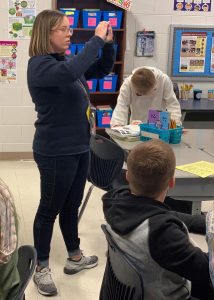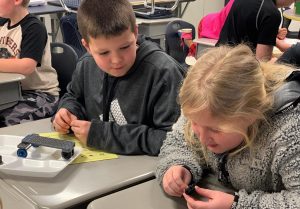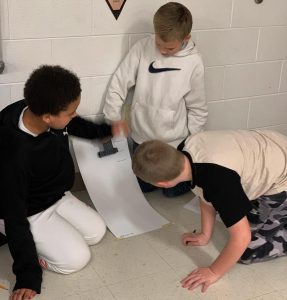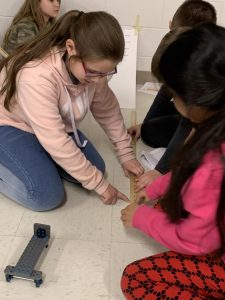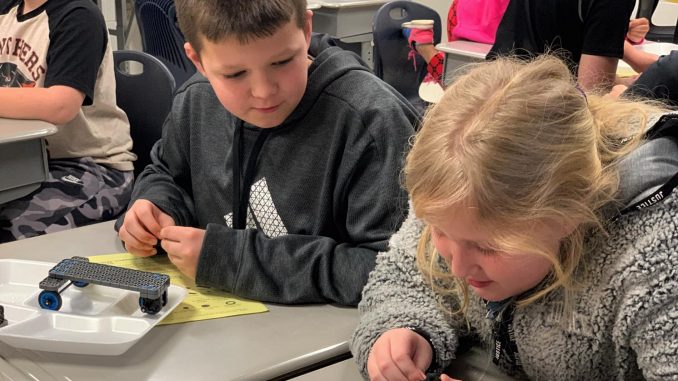
Step into Kristen Hinkle’s science class at Central Elementary and you may be confused with what you see. Instead of seats in rows and students learning from a textbook, you will find trays of plastic pieces that will create the driving vehicle for the day’s lesson.
The lesson is part of the Project Lead the Way launch curriculum designed for elementary students. The curriculum is to begin their exploration of robotics and engineering by learning basic science principles.
Students started by gathering all necessary parts from their VEX kits (robot building kits) using a part list. To keep everything organized they were given foam trays to put parts in. Once they identified what parts they would need the building began.
“While following my directions they built their VEX vehicles. I wanted to use myself as their guide to practice listening skills,” said Hinkle. So instead of electronic visuals or a step by step guide, Hinkle verbally gave students directions. “It worked so well,” she was excited to share.
After vehicles were built, they used poster board ramps with measurements to test their vehicles. Before their first launch, they predicted how far the vehicle would go after it was placed at different spots on the ramp.
Students quickly realized that the higher the resting point (measurement on the ramp) the more “potential energy”, as one student shouted during the lesson, that their vehicle had. Therefore the distance traveled would be greater when launched.
Once their vehicle came to a stop, they measured the distance using a ruler and recorded data into a chart. Some of their vehicles went over 100 inches when released from the 14-inch measurement. “Students couldn’t believe the difference in distances,” said Hinkle.
The lesson learned was how potential energy converted to kinetic energy when their vehicle rolled down their ramp.
“We have covered energy over the past few weeks and as much as I demonstrated potential and kinetic energy, the students didn’t truly grasp it until they began this activity,” said Hinkle.
One student said, “I never realized how important potential and kinetic energy is. Without them, our vehicle would stay still.”
In addition to the listening skills that impressed Hinkle, the lesson also required students to utilize math skills such as addition, division, and measurement.
Project Lead the Way in Action
The robotic lesson to teach energy was not the first time that Hinkle has used Project Lead the Way lessons and the VEX robotics kit in her classroom. We asked her to reflect on how the curriculum and having the robots has changed the way students learn science.
When I introduced the VEX construction kits to my students, I gave them time to explore the pieces. I got many excited looks when I told them they could play and build for the last 30 minutes of class. What they didn’t know is they weren’t just playing, they were researching how the pieces fit and come apart. I could have easily taught this, but would they learn? STEM in the classroom is involving your students in learning, it’s not just teaching them. They’re getting to use higher-order thinking to solve problems and create new ideas.
“Science is a topic that can be uninteresting if it’s only taught with pencil and paper, but when you change your lessons to include STEM, student engagement is no longer a problem. When STEM is involved, EVERY student regardless of ability level, wants to be apart of the learning process to show what they know.
When I first started using STEM in the classroom I soon realized that the typical structured classroom of students in their seats, reading, and working was no more. My classroom turned into organized chaos on most days. Some days it seems like there’s no way they’re learning, but they are. They are working with their groups, encouraging each other, and solving problems every day. They’re engaged and as a teacher, that’s a top priority.

